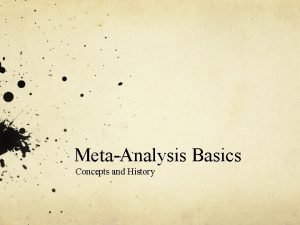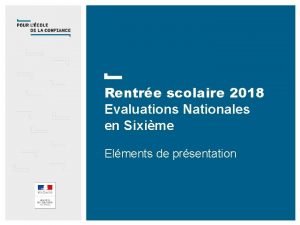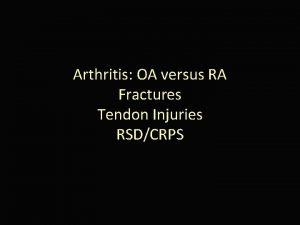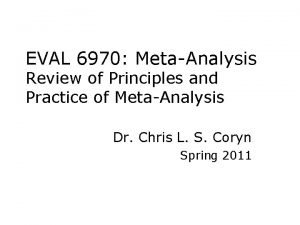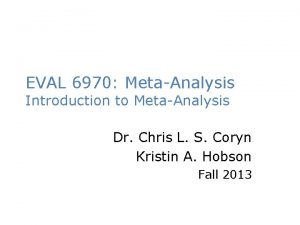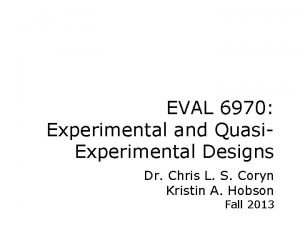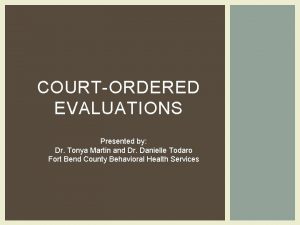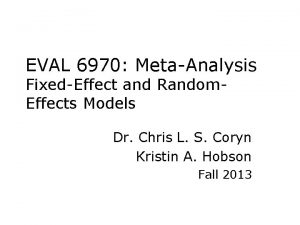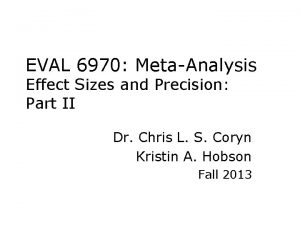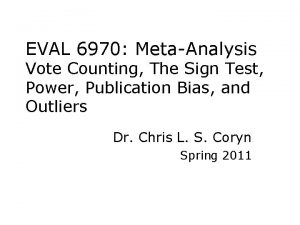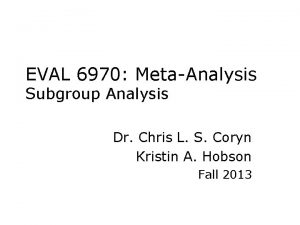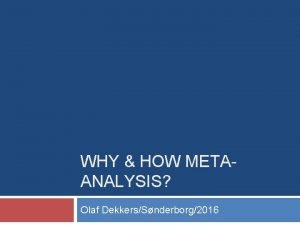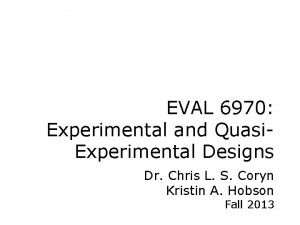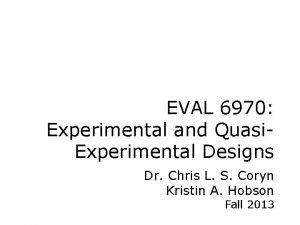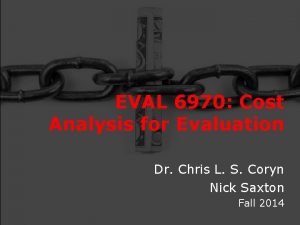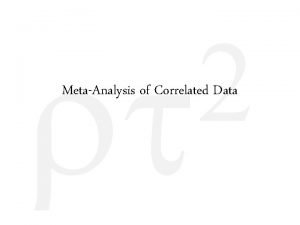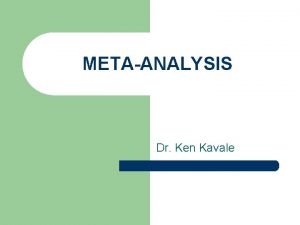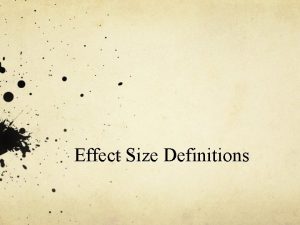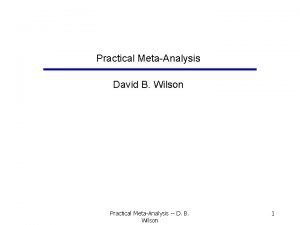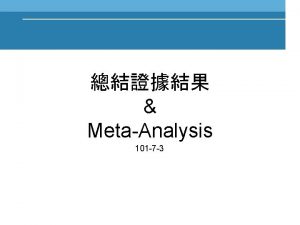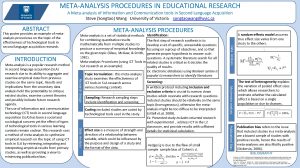EVAL 6970 MetaAnalysis MetaRegression and Complex Data Structures


























- Slides: 26

EVAL 6970: Meta-Analysis Meta-Regression and Complex Data Structures Dr. Chris L. S. Coryn Spring 2011

Agenda • Meta-regression – In-class activity • Complex data structures – In-class activity

Meta-Regression • Used to estimate the impact/influence of categorical and/or continuous covariates (moderators) on effect sizes or to predict effect sizes in studies with specific characteristics • A ratio of 10: 1 (studies to covariates) is recommended

Fixed-Effect Model

Fixed-Effect Model ANOVA information

Fixed-Effect Model ANOVA Table 121. 49992 1 0. 00000 30. 73309 11 0. 00121 152. 23301 12 0. 00000

Random-Effects Model

Random-Effects Model

Random-Effects Model Fit •

Proportion of Covariate Explained Variance • In meta-analysis, the total variance includes both variance within studies and between studies • Study-level covariates explain only the between-studies portion of the variance

Use the fixed-effect meta-analysis results (not meta-regression results)

Results from random-effects meta-regression using method of moments

Variance Explained by Covariate

Today’s First In-Class Activity •

Complex Data Structures • Main categories of complex data structures – Independent subgroups within a study – Multiple outcomes or time-points within a study – Multiple comparisons within a study • The first two are (relatively) easily handled in Comprehensive Meta. Analysis 2. 0

Independent Subgroups within a Study •

Combining Across Subgroups • Option 1 a (effect size is computed within subgroups) – Treat each subgroup as a separate study • Interest is in between-subgroup variation • Option 1 b (effect size is computed within studies) – Compute a composite score and use the composite score for each study as the unit of analysis • Interest is in between-study variation

Combining Across Subgroups • Option 2 (ignore subgroup membership) – Collapse across subgroups to compute a summary effect size and variance – Subgroup membership is considered unimportant and is ignored (and its variance is not part of the summary effect size or standard error) – Essentially a main effect meta-analysis

Multiple Outcomes or Time-Points within a Study • When a study reports data on more than one outcome, or over more than one timepoint, where outcomes or time-points are based on the same participants (i. e. , dependent), the options are 1. Compute a composite effect size accounting for the correlation between outcomes or time -points 2. Compute a difference between outcomes or time-points accounting for the correlation between outcomes or time-points

Combining Outcomes or Time-Points • The effect size for two outcomes or time-points is computed as • With variance of the combined mean

Combining Outcomes or Time-Points • For more than two outcomes or timepoints • With variance of

Combining Outcomes or Time-Points •

Comparing Outcomes or Time-Points within a Study • The effect size for the difference between two outcomes or timepoints is computed as • With variance

Comparing Outcomes or Time-Points •

Multiple Comparisons within a Study • When a study reports multiple comparisons between more than two (dependent) groups (e. g. , treatment variant A, treatment variant B, and control group C), the options are 1. Compute a summary effect for the active intervention (combing A and B) versus control (C); the same as option 2 for independent subgroups 2. Compute a difference for interventions A and B (ignoring C)

Today’s Second In-Class Activity • From the “Complex Data Structures Multiple Outcomes or Time. Points. CMA” data set – Conduct fixed-effect analyses (1) using composite effect sizes within studies and (2) treating each outcome as the unit of analysis – Interpret and explain both analyses (including all relevant statistical tests)
 What is metaanalysis
What is metaanalysis Comprehensive metaanalysis
Comprehensive metaanalysis Homology
Homology Bruno dislikes sitting on the beach
Bruno dislikes sitting on the beach Ghon complex
Ghon complex Simple, compound and complex sentences quiz
Simple, compound and complex sentences quiz Oedipus complex and electra complex
Oedipus complex and electra complex The electra complex
The electra complex Sublimation psychology
Sublimation psychology Dep taocloud
Dep taocloud Qualit eval
Qualit eval Bbs eval nibis
Bbs eval nibis You better pay attention
You better pay attention Navy eval closing statements early promote
Navy eval closing statements early promote Eval command
Eval command Initial eval
Initial eval Wveis ed eval
Wveis ed eval Cpo eval bullets
Cpo eval bullets Requestmidiaccess
Requestmidiaccess Dr eval
Dr eval Dr eval
Dr eval Dr eval
Dr eval Tonya insanity
Tonya insanity What are the two parts of a sentence
What are the two parts of a sentence Descriptive mining of complex data objects
Descriptive mining of complex data objects Mining complex types of data
Mining complex types of data Cs 412 introduction to data mining
Cs 412 introduction to data mining
